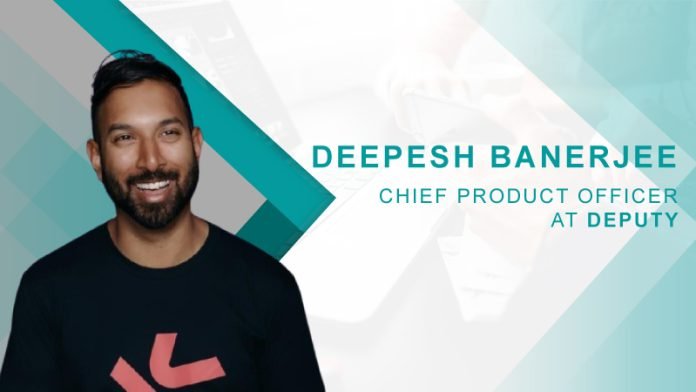Deepesh, welcome to HRTech Cube! Before we dive in, could you share your journey to becoming Chief Product Officer at Deputy, focusing on your background in HR technology and product development?
Certainly. Thank you for having me!
I began my journey in technology as a Software Engineer at SAP and Blackberry, where I developed software for one of the first mobile databases, as well as a 3G protocol stack on the Blackberry mobile smartphone.
My first leadership position in product development was at Everyday Health Group. There, I served as VP of Product and was responsible for product/business strategy and delivering consumer platforms across multiple health categories. I eventually landed in the same role at Paramount, where I led product strategy, design, and delivery for all CBS Sports Digital products – serving 70 million monthly users at the second largest sports property in the U.S.
It wasn’t until I became the Chief Product & Technology Officer at Beem that I oversaw product management, engineering, and design teams. In this role, I led the creation of Australia’s first digital wallet and scaled it to over 1 million users.
These experiences grew my knowledge and passion for product development and prepared me for my current role as Chief Product Officer at Deputy.
Deputy HR Solution is designed to streamline hiring, recruitment, and onboarding processes. What inspired Deputy to develop such a comprehensive toolset for HR professionals?
Across the U.S., hourly workers often face disjointed, frustrating, and non-communicative hiring processes.
Deputy is currently used by 330,000 workplaces globally to strengthen employer-employee connections and revolutionize scheduling processes. We were inspired to address these hiring challenges by designing a mobile-first solution with hourly workers at the forefront. While knowledge workers have access to cutting-edge technologies, hourly workers often lack similar advancements. We launched Deputy HR to allow prospective employees and managers to reap the benefits of technology, expediting organizational growth and success.
The platform was built from the ground up to be mobile-first, providing candidates with a seamless experience. With Deputy HR, new hires can get up and running in no time and without any manual data entry. Managers can collect signed contracts and employee details all within the Deputy app.
Additionally, Deputy HR allows employers to send simple text updates to candidates, cultivating a transparent and communicative hiring process.
What personal strategies or philosophies do you apply when leading product innovation at Deputy, especially in enhancing the user experience and meeting diverse customer needs?
Start with the customer. That includes my own time. As an executive, I devote a meaningful amount of time each week to meet directly with customers, understand their priorities, discuss opportunities, and build insights into enhancing their user experience and meeting their needs. And it’s not just listening – it’s listening with an active, curious mind, asking probing questions, and relentlessly asking, “Is there a better way?” and sense-checking that with customers.
How has Deputy HR transformed the hiring and onboarding experiences for businesses and workers, aligning with the evolving needs of the global workforce?
With about 80% of the global workforce classified as hourly workers, the need for a simple, intuitive, and efficient workforce solution is clear. Deputy HR aims to improve the overall hiring, recruitment, and onboarding experiences of HR professionals, business owners, and hourly workers.
Deputy HR mitigates the challenge of finding suitable candidates for available roles. The platform simplifies the onboarding process and provides employers with a centralized hub for tasks, including employee onboarding and training. With Deputy HR, customizable checklists and automated workflows reduce onboarding time by 30-45 minutes per hire, ensuring a consistent and engaging experience right at the start.
Could you elaborate on some key features of Deputy HR, such as QR Code Integration and the Video Interview Feature, and how these functionalities specifically benefit HR teams and job seekers?
Deputy HR offers a unique combination of features specifically designed to address the needs of the hourly workforce and HR teams. These features include:
- An optional “Video-Based Applicant Tracking System” that screens candidates by their personality, not their resume, and communicates with candidates over text — the way they increasingly prefer to communicate.
- Deputy HR’s “New Hire Onboarding” easily collects signatures, bank details, and state and federal level forms so new hires can start working immediately and get paid quickly.
- “Mobile-First Accessibility” allows managers to trigger employee onboarding straight from a mobile device. Employees can also sign and upload necessary documents remotely from their mobile app.
- “Centralized Document Management” digitally stores and automatically surfaces expired documents. For example, Deputy HR can surface expired documents such as “responsible serving of alcohol licenses” or “working with children checks,” depending on the industry.
The deputy emphasizes enhancing employee engagement and reducing turnover. How does Deputy HR achieve this, and what role does technology play in fostering a more engaged workforce?
With Deputy Engagement, employers can easily track workforce engagement and identify challenges – before they become a reason for turnover.
As part of Deputy HR, customers also gain access to Shift Pulse +, which builds on the existing Deputy Shift Pulse feature. This feature helps employers to collect continuous feedback from employees by asking them to rate how they felt about each shift on a sliding scale. With Shift Pulse +, employers can configure the frequency of when Shift Pulse is triggered and activate the feature for specific roles. Additionally, Shift Pulse + allows customers to create custom questions, labels, and emojis.
Armed with these insights, business leaders can make necessary changes to boost employee engagement and retention. Employers can also create Shift Pulse reports that provide valuable snapshots of workforce engagement across various time periods and locations.
Based on your experience, what advice would you give to HR professionals looking to streamline their hiring and onboarding processes effectively using technology, like Deputy HR?
There’s so much opportunity for HR practices in frontline work to be thoughtful and designed with the worker in mind.
- Prioritize mobile-friendly processes (e.g., one-click apply, text applications) for easier access by frontline workers to have easier access.
- Use AI-driven and text-based screening and chatbots to filter a high volume of candidates quickly, but still answer common questions in a timely manner.
- Implement video interviews and automated scheduling to accommodate varied schedules and let personality shine.
- Streamline onboarding with mobile-optimized digital paperwork and training modules.
- Integrate hiring systems with shift scheduling software for smoother transitions, to go from shift shortage to new role in minutes.
- Use data analytics to track metrics like time-to-hire and turnover rates, optimizing processes over time through continuous improvement.
What are some common challenges faced by organizations in managing HR processes, and how does Deputy HR address these challenges through its platform?
Aside from complicated and lengthy recruitment/onboarding processes, many organizations still face hours of managing endless paperwork and keeping track of essential employee documents in different places.
Deputy HR aims to save business owners and HR professionals from hours of keeping track of paperwork by making them accessible in a singular hub.
This holistic approach improves job mobility, acting as a sort of ‘portable passport’ for shift workers. With advanced search and filtering options, businesses can store and retrieve important documents, such as contracts, certifications, and performance reviews.
Looking ahead, what are the future innovations or developments Deputy is focusing on to further enhance its HR solutions and support HR professionals globally?
Hourly worker HR is very different than HR for knowledge workers – there is a lack of purpose-built solutions for mobile, frontline-focused performance management, employee surveys, learning, and management systems. As these industries have high turnover, “you’re always hiring, training, and setting performance benchmarks” in the first 30 days of employment. Hourly worker HR Is largely underserved, and Deputy is here to help.
In closing, what final thoughts or insights would you like to share with our audience about the intersection of HR technology and enhancing workplace efficiency and engagement?
HR technology is a key to enhancing workplace productivity,
- Data-driven HR: Analytics inform smarter decisions on hiring and retention.
- Personalization boosts engagement: AI tailors experiences to individual employees.
- Automation frees HR for strategy: Routine tasks are handled by tech, and humans focus on the impact.
- Real-time feedback loop: Continuous pulse checks identify and solve issues quickly.
- Anywhere, anytime access: Cloud HR tools empower flexible, efficient workforces.
Explore HRTech News for the latest Tech Trends in Human Resources Technology.

Deepesh Banerjee Chief Product Officer at Deputy
Deepesh is Chief Product Officer at Deputy where he leads their talented design, engineering, product management teams, leading product/technical direction, and building teams to deliver on that vision. He's skilled in Digital Strategy, Business Strategy, and Product Management.













